
The Chicago Bears are a professional American football team based in Chicago. The Bears compete in the National Football League (NFL) as a member club of the league's National Football Conference (NFC) North Division. The Bears have won nine NFL Championships, including one Super Bowl, and hold the NFL record for the most enshrinees in the Pro Football Hall of Fame and the most retired jersey numbers. The Bears have also recorded the second-most victories of any NFL franchise, only behind the Green Bay Packers, who they have a long-standing rivalry with.
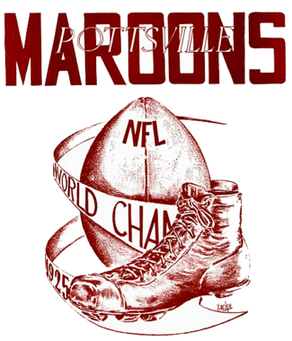
The Pottsville Maroons were an American football team based in Pottsville, Pennsylvania, in the northeastern part of the state. Founded in 1920, they played in the National Football League (NFL) from 1925 to 1928. In 1929 they relocated to Boston, where they played one season as the Boston Bulldogs.

The Orange Tornadoes and Newark Tornadoes were two manifestations of a long-lived professional American football franchise that existed in some form from 1887 to 1941 and from 1958 to 1970, having played in the American Amateur Football Union from 1888 to 1895, the National Football League from 1929 to 1930, the American Association from 1936 to 1941, the Atlantic Coast Football League from 1963 to 1964 and 1970, and the Continental Football League from 1965 to 1969. The team was based for most of its history in Orange, New Jersey, with many of its later years in Newark. Its last five seasons of existence were as the Orlando Panthers, when the team was based in Orlando, Florida. The NFL franchise was sold back to the league in October 1930. The team had four head coaches in its two years in the NFL – Jack Depler in Orange, and Jack Fish, Al McGall and Andy Salata in Newark.

The Rock Island Independents were a professional American football team, based in Rock Island, Illinois, from 1907 to 1926. The Independents were a founding National Football League franchise. They hosted what has been retrospectively designated the first National Football League game on September 26, 1920 at Douglas Park. The Independents were founded in 1907 by Demetrius Clements as an independent football club. Hence, the team was named the "Independents."
The Staten Island Stapletons, also known as the Staten Island Stapes, were a professional American football team founded in 1915 that played in the National Football League (NFL) from 1929 to 1932. The team was based in the Stapleton section of Staten Island. They played under the shortened nickname the "Stapes" the final two seasons. Jack Shapiro, who was a blocking back for the Stapletons, was the shortest player in NFL history.

Harold Edward "Red" Grange, nicknamed "the Galloping Ghost" and "the Wheaton Iceman", was an American professional football halfback who played for the Chicago Bears and the short-lived New York Yankees. His signing with the Bears helped legitimize the National Football League (NFL).

George Stanley Halas Sr., nicknamed "Papa Bear" and "Mr. Everything", was an American football end, coach, and executive. He was the founder and owner of the Chicago Bears of the National Football League (NFL), and served as his own head coach on four occasions. He was also lesser-known as a player for the New York Yankees of Major League Baseball (MLB). He is the namesake for the NFC Championship trophy.
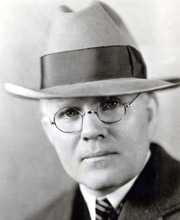
Joseph Francis Carr was an American sports executive in football, baseball, and basketball. He is best known as the president of the National Football League from 1921 until 1939. He was also one of the founders and president of the American Basketball League (ABL) from 1925 to 1927. He was also the promotional director for Minor League Baseball's governing body from 1933 to 1939, leading an expansion of the minor leagues from 12 to 40 leagues operating in 279 cities with 4,200 players and attendance totaling 15,500,000.
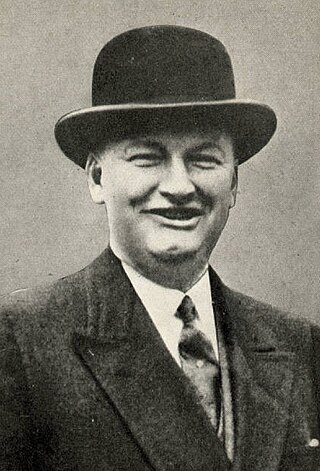
Timothy James Mara was the American founding owner of the New York Giants of the National Football League (NFL). The Giants, under Mara, won NFL championships in 1927, 1934, 1938, and 1956 and divisional titles in 1933, 1935, 1939, 1941, 1944, 1946, and 1958.
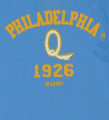
The Philadelphia Quakers were a professional American football team that competed in the first American Football League in 1926 and won the league's only championship.
The 1925 Chicago Bears season was their sixth regular season completed in the National Football League. The team was unable to improve on their 6–1–4 record from 1924 and finished with a 9–5–3 record under head coach George Halas earning them a seventh-place finish in the team standings, their worst showing to that date. However, the 1925 Bears were the most notable team in the young NFL's history to that point all because of the addition of college players, including Red Grange.
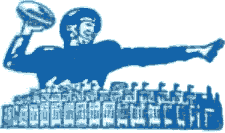
The history of the New York Giants from 1925 to 1978 covers the American football franchise from the team's inception until the conclusion of their tumultuous 1978 season. Currently members of the NFL's National Football Conference, the Giants were founded in 1925 by original owner Tim Mara in the then five-year-old NFL. Mara gave control of the team over to his two sons—Wellington and Jack—early in their lives. During this period in their history the Giants acquired four NFL championships, but also suffered some down times, including consecutive non-playoff seasons from 1964 to 1978.
The first American Football League (AFL), sometimes called AFL I, AFLG, or the Grange League, was a professional American football league that operated in 1926. It was the first major competitor to the National Football League (NFL). Founded by Charles "C.C." Pyle, (1882–1939), and General Charles X. Zimmerman, (1865–1926), as vice president and starring Hall of Fame halfback Harold Edward "Red" Grange, (1903–1991), the short-lived league with nine teams competed against the more established – then six-year-old – NFL, both for players and for fans. While Pyle's and Grange's New York Yankees team and the already established Philadelphia Quakers became reliable draws, the lack of star power and the uncertain financial conditions of the other seven teams led to the league's dissolution after one season.

The New York Giants, an American football team which plays in the National Football League (NFL), have had a long, and at times turbulent financial history. The Giants were founded in 1925 by businessman and bookmaker Tim Mara with an investment of 500 US$, and became one of the first teams in the then five-year-old NFL. Mara passed ownership of the team on to his sons Wellington and Jack after the 1929 Stock Market Crash to insulate the team from creditors. At first the Mara sons owned the team in name only, but they took increasingly larger roles in the organization beginning in the mid-1930s. Tim Mara remained involved in the team's operations until his death in 1959, when his sons assumed full control of the club. After Jack's passing in 1965, his son, Tim, took over his share of the team.

The 1925 National Football League (NFL) Championship, claimed by the Chicago Cardinals, has long been the subject of controversy, centering on the suspension of the Pottsville Maroons by NFL commissioner Joseph Carr, which prevented them from taking the title. The Maroons were one of the dominant teams of the 1925 season, and after defeating the Chicago Cardinals 21–7 on December 6, they came away with the best record in the league. However, Carr suspended and removed the team from the NFL after they played an unauthorized exhibition game in Philadelphia, on the grounds that they had violated the territorial rights of the Frankford Yellow Jackets. Chicago played and won two more games against weak NFL opponents, but were sanctioned because Cardinals player Art Folz hired four Chicago high school football players to play for the Milwaukee Badgers under assumed names to ensure a Cardinals victory.
The 1926 AFL season is the only season of the first American Football League. It started with nine teams, with the initial game of the season being played in front of 22,000 fans in Cleveland, Ohio, but by the end of the season, only four teams were still in existence: three teams owned or subsidized by league founder C. C. Pyle and star Red Grange and league champion Philadelphia Quakers. The initial lineup of teams included the traveling Wildcats and a charter member of the National Football League, the Rock Island Independents, which became a second traveling team after having poor attendance in its first three games.

Charles C. "Charlie" Pyle, sometimes called "Cash and Carry Pyle," was a Champaign–Urbana, Illinois theater owner, sports agent, and sports entreprenuer best known for his representation of American football star Red Grange and French tennis player Suzanne Lenglen.
The Los Angeles Wildcats was a traveling team of the first American Football League that was not based in its nominal home city but in Chicago, Illinois. Coached by Jim Clark, the team was designed to be a showcase for University of Washington star back George “Wildcat” Wilson. Compared to most traveling teams in professional football, the Wildcats were successful, compiling a 6–6–2 record in the only season of the team's – and the league's – existence.
The Cleveland Panthers were a professional American football team. They were an independent team founded in 1919 from the remains of the Youngstown Patricians. The Panthers played, with various degrees of success, continuously from 1919 and eventually, as fewer opponents played them each year after 1926, sputtered to a quiet folding in 1933.
The Chicago Bulls were a professional American football team that competed in the first American Football League in 1926. Owned by Joey Sternaman, the Bulls also had AFL founders C. C. Pyle and Red Grange as shareholders. Joey Sternaman was also the coach and blocking back for the Bulls throughout their brief existence.













